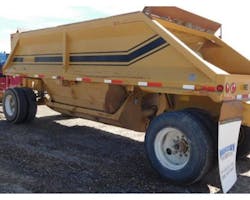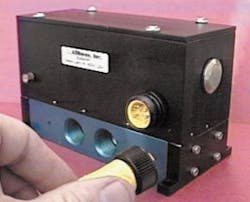Bottom-dump trailers have opposing hinged doors located beneath their beds. To unload material from the bed, these doors are opened with a set of large air cylinders. By feathering the valve that controls the cylinders, the driver can position the doors to throttle the delivery of the material while he or she drives the truck. Or an operator walking alongside the vehicle can operate the doors from that vantage point. Bottom-dump trailers often are used for long stretches of road construction because this door configuration and control allows them to deposit material evenly as they travel.
The air valve that manipulates the doors is typically a 3-position, blocked-center model. There are a number of designs available, but they must all provide that the doors can be opened or closed or maintained in a given position. The valve must be capable of being operated with an electrical signal from the driver's cab or manually from an external station.
Now imagine a parked truck loaded with gravel and the driver somewhere else having lunch. Somebody passing by decides to experiment with the shiny handle on the valve located on the back of the truck. Suddenly, there's a major mess to clean up.
AIRman Inc., Walled Lake, Mich., avoids this potential problem with a valve that locks itself out electrically until the driver wants to operate it. AIRman's design consists of a ½-in. NPT, 4-way, 3-position, blocked-center, double-air-pilot valve fitted with three solenoid-actuated 3-way valve operators. All valves are permanently lubricated with grease designed to take the rigors of outdoor operation that includes high volumes of condensation and dirt in the compressed air.
In this circuit, the first solenoid must be energized to provide supply air to the other operators. The first solenoid receives its electrical signal exclusively from the driver's cab. With no signal to the first operator, the entire valve is inoperable, and the dump-door cylinders are held in their last position. Once the driver energizes the first solenoid, the other solenoids can shift the 4-way valve to open or close the doors.
The valve enclosure profile is designed to minimize unwanted attention and maximize protection from abuse common in the construction environment. The solenoid enclosure is directly interfaced to the 4-way valve to eliminate any external connections. Flush-mounted, weather-tight electrical push buttons located on the sides of the enclosure allow manual operation of the valve from outside the cab. The valve also is available on a pendant that lets the operator to stand 20 ft away from the truck.
For more information, contact Chad Dusseau at [email protected], call (248) 960-5865, or click here.


